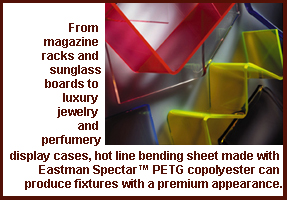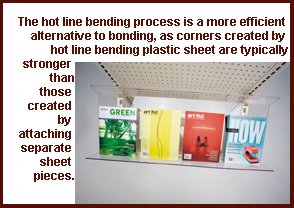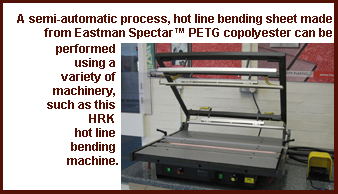As the number of brands
competing for consumer
attention at point-of-purchase
reaches an all-time high,
retailers are pressed to find ways
to maximize the use of merchandising
space and create a welcoming
environment for shoppers.
From magazine racks and
sunglass boards to luxury jewelry
and perfumery display cases, fabricators
 are increasingly required
to handle a large number of retail
fixture requests on short notice.
are increasingly required
to handle a large number of retail
fixture requests on short notice.
For these professionals, adequately
responding to marketplace demands requires finding
new ways to enhance production efficiencies.
Hot line bending is a process
that many fabricators in the U.S.
and Europe use to produce fixtures
with a premium appearance.
Traditionally performed
with acrylic sheet, this process is
becoming revamped as fabricators
turn to alternative plastic
materials, such as PETG sheet.
Offering a variety of advantages for hot line bending,
including ease of processing and excellent cost-benefit
ratio, this clear, durable material can help fabricators
boost production efficiencies and meet the retail industry’s
needs for high-quality aesthetics and performance.
Hot Line Bending
Hot line bending is a fabrication technique for plastic
sheet used to create a variety of retail fixtures, including
magazine and brochure holders, shelving and high-end
displays. This process is a more efficient alternative to
bonding, as corners created by hot line bending plastic
sheet are typically stronger than those created by attaching
separate sheet pieces. This enhanced strength provides
displays with more durability to withstand the harsh
retail environment, decreasing the risk of breakage and
extending fixture lifespan.

When performing hot line bending, the fabricator heats
an area of flat plastic sheet until he can bend it without
any pull back. Depending upon the size of the heated
area, the sheet can be bent to a predetermined angle. To
optimize results, the heated area should be at least twice
the sheet’s thickness and no more than three to five times
the size. Once bent, the sheet can be placed in a cooling
jig to maintain the proper angle while the heated area
returns to a stabilized temperature.
A semi-automatic process, hot line bending can be performed
using a variety of machinery. The industry standard
is a straight nickel-chromium (nichrome) resistance
wire heater, which is ideal for standard-sized sheets with
thicknesses of up to 6 mm. Other types of heaters can be
used for projects with special requirements, including very
thick or
large plastic
sheet
pieces.
Hot line
bending is
ideal for
fixture
projects
requiring
rounded
corners,
as the
process
does not
produce sharp or jagged edges. Currently, the look produced
by such rounded edges is growing in popularity
among retailers, who are increasingly incorporating more
modern, organic shaping and aesthetics into stores for a
warm, non-industrial consumer environment.
PETG Sheet and Production Efficiencies
PETG sheet offers a number of advantages for
 fabricators
looking to maximize the efficiency of hot line bending
processes. Possessing a lower glass transition temperature
(Tg) than acrylic, PETG requires less heat to reach
process temperature. This property allows PETG sheet to
undergo
the heating
and
cooling
stages
more
quickly,
allowing
fabricators
to save
energy,
increase
production
rates
and
respond
quickly to project requests and tight deadlines.
fabricators
looking to maximize the efficiency of hot line bending
processes. Possessing a lower glass transition temperature
(Tg) than acrylic, PETG requires less heat to reach
process temperature. This property allows PETG sheet to
undergo
the heating
and
cooling
stages
more
quickly,
allowing
fabricators
to save
energy,
increase
production
rates
and
respond
quickly to project requests and tight deadlines.
The material’s inherent durability also allows PETG
sheet to be downgauged without sacrificing integral
strength. Downgauging further reduces the heat needed
to reach process temperature and bend the sheet, saving
even more energy and time during the hot line bending
processes. PETG sheet also does not require pre-drying,
helping to amplify these savings.
Eastman Chemical Company recently produced a study
on the hot line bending performance of PETG sheet compared
to other plastic materials. This study used a double-sided, straight nichrome wire resistance heater powered
to 200°C.
The study’s results, displayed in Chart 1, reveal that at
a 5 mm thickness, acrylic sheet takes a minimum of 65
seconds to bend and 229 seconds to cool, for a total processing
time of 294 seconds. Comparatively, 5 mm thick
PETG sheet takes a minimum of 55 seconds to heat and
143 seconds to cool, totaling 198 seconds. Comparing
these statistics, the use of PETG sheet for hot line bending
represents an average increase in time efficiency of 30
percent over acrylic sheet – a marked improvement.
The study also demonstrates that this efficiency could
be further enhanced when factoring in the downgauging
abilities of PETG sheet. To achieve the same durability as
5 mm thick acrylic sheet, PETG sheet can be downgauged
to a 3.5 mm thickness. This 28 percent material thickness
reduction corresponds to a related reduction in the time
and energy needed for hot line bending.
The study has further implications for fabrication efficiencies.
As PETG sheet requires less heat to hot line
 bend, the material incorporates less strain over the course
of the bending process. Combined with PETG’s inherent
impact resistance, this lower strain level allows fabricators
to produce more durable retail fixtures, resulting in longer
fixture lifespan, minimized replacement needs due to
breakage and enhanced product safety.
bend, the material incorporates less strain over the course
of the bending process. Combined with PETG’s inherent
impact resistance, this lower strain level allows fabricators
to produce more durable retail fixtures, resulting in longer
fixture lifespan, minimized replacement needs due to
breakage and enhanced product safety.
These advantages also hold benefits for fabricators on
an environmental level. Sustainability is an increasingly
important issue for retailers, and top chains like Wal-Mart
and Marks & Spencer have developed and implemented
programs that define specific criteria for reducing overall
environmental impact throughout the supply chain. As an
interconnected part of this chain, fabricators are held
accountable for their use of resources. By utilizing PETG
sheet for hot line bending, fabricators can save material
and energy while also enhancing internal efficiencies, making
their businesses friendlier for the environment as well
as the bottom line.
As fabricators search for new ways to enhance hot line
bending efficiencies in order to keep up with demand for
quality retail fixtures, PETG sheet offers a number of benefits,
including superior impact resistance, ease of processing
and freedom of design. The material’s lower Tg
compared to acrylic sheet also allow fabricators to save
time and energy when hot line bending. These properties
enable the creation of more durable, long-lasting fixtures
for retailers and more efficient and sustainable production
practices for fabricators.
Written by Matthias Schönfeld, Specialty Plastics
Technical Service and Stefan Alves, Market Development
Manager, Specialty Plastics, Eastman Chemical
Company.